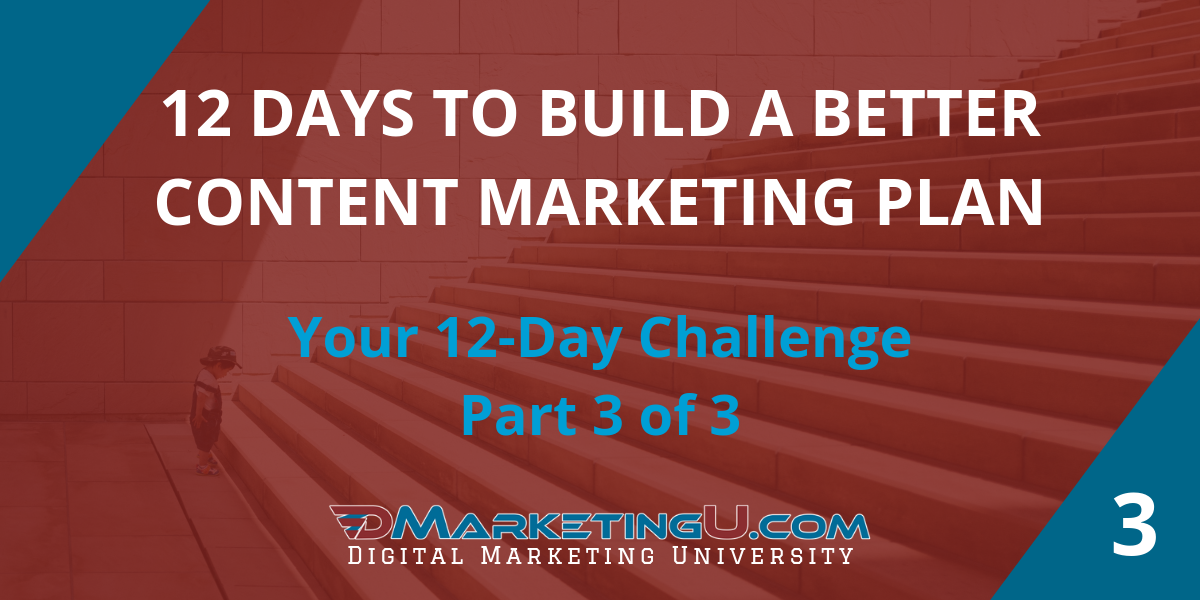
12 Days to Build a Better Content Marketing Plan: Part Three of Three
Just imagine what your world would be like without tools. What if your favorite time-saving tool in the kitchen was never invented? How much time would you lose each day if your favorite smartphone apps were never created and you were forced to use old-school methods to do your tasks.
Now, as a planner of marketing activities, imagine if you could GAIN efficiencies with NEW time-saving tools. These types of tools exist and can help you with building a better strategic plan for your organization’s content marketing efforts. By reading this 3-part blog series, you’re just 12 days away from upgrading your Content Marketing Plan… or building your first plan!
Welcome to part three of our 12-day challenge to help you improve or build a better Content Marketing Plan. (All links to the 3-part series are in a section below) In this third part of our blog series, you’ll learn about the time-saving methods… Tools and Processes.
But first, here’s more information about the challenge.
CHALLENGE OBJECTIVE
The objective of the 12-day challenge is to provide you with guidance and tips for improving (or creating) your Content Marketing Plan — which is a documented strategy to create, publish, monitor, report and optimize content to help you reach your target audiences, fulfill their needs, plus achieve your goals and objectives.
CHALLENGE QUICK LINKS
The 12-day challenge will be covered in our 3-part blog series. Below are the links to each article in the series:
Blog Post #1: Audience Research and Analysis
- Day 1: Content Marketing Mission Statement
- Day 2: Buyer Persona
- Day 3: Buyer Journey Map
- Day 4: User Persona
- Day 5: User Journey Map
Blog Post #2: Tactical Planning
Blog Post #3: Tools and Processes Planning
[Links in this blog post!]- Day 8: Content Marketing Sales Funnel
- Day 9: Content Creation Workflow
- Day 10: Content Publishing Plan
- Day 11: Content Monitoring & Reporting Plan
- Day 12: Content Optimization Plan
THREE GROUPS OF ELEMENTS IN A CONTENT MARKETING PLAN
Note: If you read this short section in blog post #1 or #2, it’s fine to scroll down or skip to Day 8: Content Marketing Sales Funnel
When building a Content Marketing Plan, our experience and research has lead to the development of three key groups of elements that must be included in your strategic plan. Our definition of an “element” is a core component of a marketing plan that focuses on a strategic marketing area.
Group #1 – Audience Research and Analysis
Since the most important factor in any marketing plan is knowing the needs and challenges of your target audiences, the first group contains five elements related to Audience Research and Analysis. This was the group covered in the first post of our 3-part blog series.
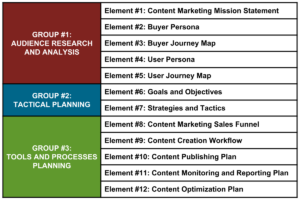
Group #2 – Tactical Planning
Once you’ve invested time to thoroughly understand the needs and challenges of your audience, now it’s time to analyze your organization’s and department’s needs in the form of goals, objectives, strategies and tactics. This stage of analysis will be documented in the Tactical Planning section of your Content Marketing Plan. This group of elements was covered in the second post of our 3-part blog series.
Group #3 – Tools and Processes Planning
After you’ve documented your audiences’ needs and your organization’s needs, the final stage is to create tools and processes that will help you improve your efficiency and productivity related to content creation, content publishing, monitoring, reporting and optimization of future and existing content. The Tools and Processes Planning group of five elements will be covered in the third post (this blog post) of our 3-part blog series.
Now that you’ve seen the objective and overview of the challenge, let’s get started with the next challenge!
DAY 8 OF 12 — Challenge #8: Content Marketing Sales Funnel
On the eighth day of this challenge, the objective is to create a visualization by mapping your Content Marketing goals and the most appropriate content types for a buyer to the sales funnel stages.
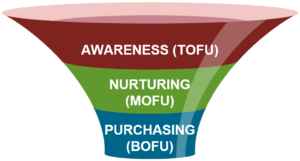 What exactly is the difference between a “sales funnel” and a “Content Marketing Sales Funnel”? A typical sales funnel is a funnel-shape graphic that lists the stages that prospects travel down (or exits) until the final stage where they make a purchase. Whereas, a Content Marketing Sales Funnel enhances the typical sales funnel by first adding a list of goals next to each stage then secondly by adding a list a content types next to each stage that are effective at converting prospects.
What exactly is the difference between a “sales funnel” and a “Content Marketing Sales Funnel”? A typical sales funnel is a funnel-shape graphic that lists the stages that prospects travel down (or exits) until the final stage where they make a purchase. Whereas, a Content Marketing Sales Funnel enhances the typical sales funnel by first adding a list of goals next to each stage then secondly by adding a list a content types next to each stage that are effective at converting prospects.
This helpful tool is most frequently used in the planning phase for developing new content to help you achieve your goals. So, the benefits are:
- documenting which content types help you achieve which goals in which sales stage.
- providing a list of content type options to choose from for marketing campaigns.
- assisting in decision making to make sure your content helps you achieve your goals.
- providing a collaboration tool for Sales and Marketing to work together to achieve goals.
When creating your own customized Content Marketing Sales Funnel, the three key elements to include are:
- Stages of a sales funnel, typically listed as Top of the Funnel (TOFU), Middle of the Funnel (MOFU), and Bottom of the Funnel (BOFU).
- Goals from your content marketing plan, which you developed on Day 6 of the 12-day challenge.
- Content Types that are effective with your buyers, such as blog posts, videos, demos, graphics, white papers, price sheets, etc.
You may want to use a spreadsheet to list the stages in one column, goals in the next column, and content types in the final column. Then, map your goal to the appropriate sales stage and your content type(s) to the best sales stage and goal.
In our course, “How to Create a Content Marketing Plan: 12-Step System to Success“, we dedicate an entire chapter of training to teach you how to create the ultimate Content Marketing Sales Funnel if you need more assistance.
Once you’ve created your Content Marketing Sales Funnel with its stages, goals and content types, complete the Day 8 challenge and build a better Content Marketing Plan by inserting your Content Marketing Sales Funnel into the plan after your goals, objectives, strategies and tactics section.
Congratulations on completing the tasks for Day 8 of the 12-day challenge! Next in this blog post will be further development of tools and processes by creating a Content Creation Workflow.

DAY 9 OF 12 — Challenge #9: Content Creation Workflow
On the ninth day of this challenge, the objective is to create a standardized process with a list of steps from concept to launch for each new piece of content.
Building new content without a workflow could be as risky as building a house without blueprints. To reduce the risks, you need a content creation workflow for the following benefits:
- Provide a standardized process to follow for each new piece of content.
- Improve clarity of the project tasks.
- Eliminate missed steps.
- Increase efficiency to create new content.
- Provide accountability.
With a well-defined workflow, your content creation team will consistently meet and exceed the objectives for new content projects.
Your content creation workflow should contain a minimum of these five (5) steps or processes:
- Concept evaluation
- Planning
- Development
- Review process
- Approval
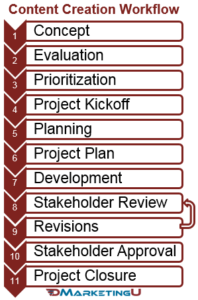 In our online course “How to Create a Content Marketing Plan: 12-Step System for Success”, we dedicate an entire chapter and over 55 pages of training to teach you how to improve your content creation workflow. In the course, we also go in-depth about the 11 processes that we recommend in a Content Creation Workflow. The full training module of Step 9 of our 12-step system helps you create and customize the following four tools:
In our online course “How to Create a Content Marketing Plan: 12-Step System for Success”, we dedicate an entire chapter and over 55 pages of training to teach you how to improve your content creation workflow. In the course, we also go in-depth about the 11 processes that we recommend in a Content Creation Workflow. The full training module of Step 9 of our 12-step system helps you create and customize the following four tools:
- Content Creation Form
- Content Creation Workflow
- List of Content Roles, Goals and Ideas
- Key Hashtags List
Feel free to customize your list of processes as needed for the unique needs of your organization and the resources that you have available in your content creation team.
Once you’ve created your customized workflow processes, complete the Day 9 challenge and build a better Content Marketing Plan by inserting your Content Creation Workflow into the plan after the Content Marketing Sales Funnel section.
Congratulations on completing the tasks for Day 9 of the 12-day challenge! Next in this blog post, you’ll develop more new tools and processes by creating Content Publishing Plan.
DAY 10 OF 12 — Challenge #10: Content Publishing Plan
On the tenth day of this challenge, the objective is to create a strategic plan for publishing your content so that it achieves your objectives and tactics. Your content marketing objectives, which describe WHAT to achieve with a measurement plus time to reach the related goal, were discussed in Day 6 of this challenge. Your tactics, which are specific actions on HOW to achieve your strategies, were discussed in Day 7 of this challenge.
Since this strategic plan helps you organize your objectives and actionable tactics, without it you’re directionless like a boat without a motor or sail. So, the benefits of a Content Publishing Plan are:
- providing a clear vision of the tasks.
- creating greater unity with management and team members on the same page.
- improving accountability from tactics that are assigned to team members.
- establishing the ability to track progress to identify your strengths and opportunities.
- producing the planning and publishing of content on a regular schedule for your audiences.
When creating your Content Publishing Plan, it should contain the following items:
- A section for each marketing channel in your marketing mix.
- Objectives related to that marketing channel.
- Tactics related to that marketing channel.
- Key metrics for tracking objectives and tactics.
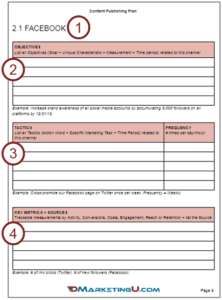 Starting with the first bullet point above, you’ll need to document all of your digital marketing channels, which are your methods of relationship building and communication to reach your desired audiences. Although at Digital Marketing University we’re primarily focused on the digital channels, you should also include any traditional marketing channels (print, TV, radio, trade shows, etc.) that are important in your content marketing efforts. For each marketing channel, I recommend creating it’s own page in your Content Publishing Plan with a page title containing the name of the channel.
Starting with the first bullet point above, you’ll need to document all of your digital marketing channels, which are your methods of relationship building and communication to reach your desired audiences. Although at Digital Marketing University we’re primarily focused on the digital channels, you should also include any traditional marketing channels (print, TV, radio, trade shows, etc.) that are important in your content marketing efforts. For each marketing channel, I recommend creating it’s own page in your Content Publishing Plan with a page title containing the name of the channel.
For each marketing channel in your publishing plan, next you’ll need to document all of the Objectives from Day 6 of this challenge that are related to this channel. After listing your Objectives, prioritize them within the group. Then, repeat the process for your Tactics by listing and prioritizing them. Finally, list your key metrics (measurements) for tracking the success of each marketing channel.
To create an in-depth publishing plan, you’ll need a mix of tools to organize the plan efficiently. If you want additional assistance, in our online course “How to Create a Content Marketing Plan: 12-Step System for Success”, we dedicate an entire chapter and over 35 pages of training to teach you how to design an exceptionally organized publishing plan.
Once you’ve created a publishing plan for one marketing channel, repeat the process for all of your channel. Then, complete the Day 10 challenge and build a better Content Marketing Plan by inserting your new Content Publishing Plan into the Content Marketing Plan after the Day 9 section about your content creation processes.
Congratulations on completing the tasks for Day 10 of the 12-day challenge! Next in this blog post will be further development of tools and processes by creating a plan for the monitoring and reporting of your content success and opportunities for improvements.
DAY 11 OF 12 — Challenge #11: Content Monitoring and Reporting Plan
On the eleventh day of this challenge, the objective is to create a strategic plan for creating and distributing reports with metrics, feedback, trends and stories about your audience, marketing campaigns and marketing channels as valuable decision-making information.
Data becomes valuable information when you can monitor (track) it then report it properly for your key decision makers and team members. Therefore, the benefits of a Content Monitoring & Reporting Plan are:
- creating an organized list of data needs for each stakeholder and their preferred delivery frequency and distribution method.
- tracking progress of your marketing efforts.
- discovering insights about marketing efforts and opportunities.
- building teamwork around achieving the desired results.
- providing accountability for achieving the desired results.
- tracking ROI of content to determine which marketing efforts are working.
To build your own customized Content Monitoring & Reporting Plan, I recommend that it should contain at least the following items:
- WHAT to monitor, based on your tactics.
- WHERE to monitor, based on your tactics.
- HOW and WHEN to report the data as helpful information.
- WHO should receive the reports.
My specific recommendation is to create a Content Monitoring & Reporting Plan in a spreadsheet with the following eight (8) column headers:
- REPORT NAME: Unique name for your report
- REPORT DESCRIPTION: The objectives or type of results
- METRICS INCLUDED: List the names and/or description of the metrics provided in the report
- DATA SOURCE(S): List where the report creator can find the data needed to produce the report
- RECIPIENTS: List the internal and external recipients and their contact information if needed
- FREQUENCY: List how often the report will be created or updated (typically monthly)
- DISTRIBUTION METHOD: Describe how the report will be provided to the recipients (typically by email)
- ASSIGNED TO: List the person or people accountable for creating, updating and distributing the report
Since each organization is unique for their reporting needs and management styles, use the eight fields above as a foundation for your own report then customize it as desired. Once you have the column headers created in your spreadsheet, you can document existing reports or create new ones and add them to the reporting plan.
After creating your customized Content Monitoring & Reporting Plan, complete the Day 11 challenge and build a better Content Marketing Plan by inserting your new Content Monitoring & Reporting Plan into after the Content Publishing Plan.
Congratulations on completing the tasks for Day 11 of the 12-day challenge! The final exercise in this blog post will be further development of tools and processes related to optimizing your existing content and their processes.
DAY 12 OF 12 — Challenge #12: Content Optimization Plan
On the twelfth and final day of this challenge, the objective is to create a strategic plan for identifying opportunities for increased engagement, cost savings, time savings or higher ROI from existing content, digital assets and marketing processes. This plan will list a series of experiments to conduct as well as the results and an action plan based on the results.
You’ve spent a great deal of money on your marketing channels and content, but are they effective? Only experiments can prove it! So, the benefits of a Content Optimization Plan are:
- improving the Return On Investment (ROI) of your investments in content, marketing channels, marketing processes and people.
- evaluating your content and identifying opportunities for improvements or savings in order to get the highest returns from your investments in content marketing.
- using the experiments’ results to increase the performance of marketing assets, which can lower customer acquisition costs and increase revenue.
To get started with your Content Optimization Plan, pick an area related to content marketing that you want to see an improvement. Examples of common areas are:
- Landing page optimization.
- Call-to-Action (CTA) optimization.
- Related to your buyer journey map (Day 3 Challenge), analyze why a prospect didn’t convert to become a buyer.
- Related to your user journey map (Day 5 Challenge), analyze why a trial user didn’t become a power user or advocate.
Typically, I like to start with a conversion point that is related to lost revenue, that way the results of increased revenue can justify the investment in an optimization experiment.
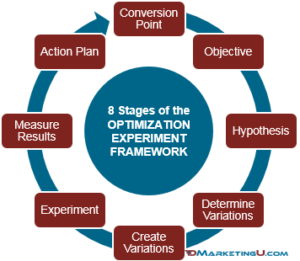 After you’ve selected a conversion point (such as the Call-to-Action link on a landing page), next you’ll need to follow a series of steps for your optimization experiment. I call this process the eight (8) stages of the Optimization Experiment Framework.
After you’ve selected a conversion point (such as the Call-to-Action link on a landing page), next you’ll need to follow a series of steps for your optimization experiment. I call this process the eight (8) stages of the Optimization Experiment Framework.
As a quick summary of the framework that is detailed in our online course “How to Create a Content Marketing Plan: 12- Step System to Success“, I’ve listed the basics about each part of the process:
- List the Conversion Point to analyze.
- Document the Objective (what to achieve) of the experiment.
- Create a Hypothesis of your expected results.
- Determine one or more variations (changes) to make, such as a button color, text link, email subject or another object.
- Develop the variations with your content development team.
- Plan, launch then end the experiment.
- Measure the results and compare against your Hypothesis.
- Create an Action Plan, which is typically to implement the result if it had a positive effect, do nothing if there was a negative effect, or plan a new experiment if the results were inconclusive.
As mentioned earlier, the Content Optimization Plan is a list of the experiments that you want to create during a time period, such as an upcoming month, quarter or fiscal year. Therefore, the plan is a report with column headers for the experiment name, the conversion point to analyze, the objective, start date, hypothesis, results, and an action plan.
Once you’ve created your own Content Optimization Plan, complete the Day 12 challenge and build a better Content Marketing Plan by inserting your new Content Optimization Plan into the plan after the Content Monitoring & Reporting section.
Congratulations on completing the tasks for Day 12 of the 12-day challenge!
CONCLUSION
To build a better Content Marketing Plan, I recommend building tools and processes for improving your content creation, publishing, monitoring, reporting and optimization strategy.
In this third blog post from our 3-part series, we provided five daily challenges containing techniques for creating new tools and processes. The first challenge taught you about creating a Content Marketing Sales Funnel, which can help you in the content creation stage to determine the best content type to select based on your goals and the prospects’ sales stage.
To create future new content, the best practice is to follow a Content Creation Workflow, which we provided our own 11-step process from conception to development to launch.
After creating your content, the last three daily challenges taught you how to create strategic plans to build your own Content Publishing Plan, Content Monitoring & Reporting Plan plus a Content Optimization Plan.
I’d love to hear your feedback from this 12-day challenge and how it helped you improve your own Content Marketing Plan. I invite you to leave your feedback in the Comments section below or answer the question, “What would you add to this 12-day challenge if you could add a 13th day? What was missing as it relates to your organization?“